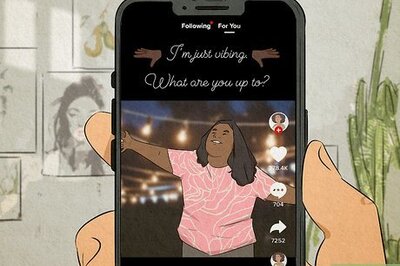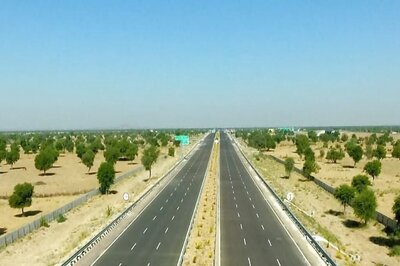
views
Why is the media devoting so much time to the Jessica Lal Murder case, ask the self-righteous and lazy media critics. The media baiters in the Jessica Lal case have missed a crucial point. In the dark rooms of their own self-absorption, lit only by the beacons of hatred towards journalists, they have failed to realize that the Jessica Lal Murder Case was not just a murder of a young woman. Instead it was a moral catastrophe of the Indian elite. It is a terrifying symbol of how even as we march towards greater prosperity, our minds are trapped in Neanderthal backwardness. Not only was it all these things, it was also a moment when the Indian middle class plunged into candle-lit introspection, when the quest for justice for Jessica became a moment for us all to think about how we are all complicit in the savage immorality of our society. The Jessica Lal Murder Case is a moment of truth for the Indian educated class: how did we come to lose all sense of personal morality? Has divine grace deserted us all? Have we all collectively declared that god is dead, as long as the sex and booze continues to flow?
On the night of 29th April 1999, the crème de la crème of Delhi's society was present at the Tamarind Court. At 1.30 am Manu Sharma demanded a drink from Jessica Lal who was tending the bar. She was a young-woman-at-the-bar. When this young-woman-at-the-bar dared to refuse Manu a drink, he simply raised his revolver and shot her. The young-woman-at-the-bar lay dead, killed by a fat-youth-from-a-rich-family-with-well-connected-parents. What's the price for the life of such a girl compared to the glorious future that awaited him? He would perhaps go on to inherit his father's fortunes and grow even fatter from booze and the good life. And what was her fate? Serve more drinks in bars perhaps. Walk the ramp to earn a living. Work in nightclubs to earn a living. What was the death of a mere chit of a girl when compared to the life of a scion of a powerful clan?
At that party, not one of Delhi's educated folk, Delhi's enlightened folk, Delhi's honourable folk spoke up for Jessica Lal. Among the guests was even a police officer, then Joint Commissioner YS Dadwal who now claims he left the party at 11pm. There were fashion designers at the party, there were celebrities, models and corporate executives. This was not a murder in darkest corners of Uttar Prdesh where ignorance and brutal poverty creates criminals from the dust. The people at Tamarind Court that night were people who are chief guests at 5 star events, who tell us What To Wear, and tell us Whats In and Whats Out and Where To Go For Our Holidays and What To Eat In Koh Samui. But when it came to a crucial test of spine, when it came to a fundamental test of personal courage, they all resoundingly failed. One lone courageous woman bore witness for the prosecution. And for her pains she was dubbed a "socialite" and made to go to prison for the license papers of her restaurant. In the Jessica Lal murder case, the most educated section of society failed to show any moral courage or backbone.
Gaze on the accused in this case. Manu Sharma, son of Vinod Sharma, former Haryana minister. Vikas Yadav, son of former Rajya Sabha MP DP Yadav. Amardeep Singh Gill or Tony Gill and Alok Khanna, then employees of Coca Cola. And Shyam Sundar, son-in-law of former president Shankar Dayal Sharma. These are alleged conspirators to murder, from the very highest echelons of power. Yet they faced no moral dilemma, they had no hesitation in covering up a murder, they felt no remorse, no guilt, no greater good sense prevailed. In fact Vikas Yadav, during his period of bail in the Jessica Lal case, came out and allegedly murdered Nitish Katara. And Vikas Yadav's father was once in the Rajya Sabha. Once he roared by in a white ambassador making every honest cyclist wait for him on the street. Citizens of India, wake up!
What is the other reason why the Jessica Lal Murder Case is a moral catastrophe? Because it shows that some sections of the police, the agents of law and order, actually worked to protect a murderer. The Special Investigation Team's report on the investigations is absolutely shocking. The report says no attempt was made by the Investigating Officer to take down the number of Manu's Tata Safari outside Tamarind Court. No photograph of the Tamarind Court ceiling where Manu fired the first bullet was taken. Investigating Officer Raman Lamba failed to arrest Manu or to collect evidences against him or to recover the Tata Safari when he went to Chandigarh. The report says Lamba arranged a meeting with Manu's father Vinod Sharma and then additional DCP Vivek Gogia and as a result of this meeting Manu's surrender was staged on 6th May 1999, a week after the murder. Manu had, by this time, allegedly given his gun to one Ravindar Sudan who had escaped to the US on May 4th. Vivek Gogia wrote a letter to the CFSL asking whether two guns were used for murdering Jessica. This latter was used to support hostile witness Shayan Munshi's two gun theory. DGP of Arunachal Pradesh Amod Kanth was then Joint Commissioner Delhi. It is impossible, says the SIT report, that senior officers did not know what their juniors were doing in this high profile case. Answer the call of your own conscience, Mr Kanth: should police officers who wilfully destroy a murder investigation not be punished?
The citizens came with their burning candles. Maybe they were just armchair activists, content to send emails instead of facing the heat and dust of a rally. Maybe their numbers were small, their voice was weak, they were only the middle class and not a mass movement. Yet they were there. They did not buy the sleazy arguments of the foul-mouthed octogenarian defence lawyer. They kept sending their wails of protest into cyberspace. Perhaps none of it is enough, perhaps none of it will bear fruit, perhaps at another glittering party another young girl will be murdered in full public view and the elite will turn its face away. But one candle-bearing citizen did ask an important question to his fellow marchers: what would we have done if we had been at that party?About the AuthorSagarika Ghose Sagarika Ghose has been a journalist for 20 years, starting her career with The Times of India, then moving to become part of the start-up team...Read Morefirst published:December 22, 2006, 10:28 ISTlast updated:December 22, 2006, 10:28 IST
window._taboola = window._taboola || [];_taboola.push({mode: 'thumbnails-mid-article',container: 'taboola-mid-article-thumbnails',placement: 'Mid Article Thumbnails',target_type: 'mix'});
let eventFire = false;
window.addEventListener('scroll', () => {
if (window.taboolaInt && !eventFire) {
setTimeout(() => {
ga('send', 'event', 'Mid Article Thumbnails', 'PV');
ga('set', 'dimension22', "Taboola Yes");
}, 4000);
eventFire = true;
}
});
window._taboola = window._taboola || [];_taboola.push({mode: 'thumbnails-a', container: 'taboola-below-article-thumbnails', placement: 'Below Article Thumbnails', target_type: 'mix' });Latest News
After an acquittal now a conviction. Manu Sharma, son of the well connected Haryana politician Vinod Sharma, has been sentenced to life imprisonment for murdering Jessica Lal. After Sharma's acquittal (along with all the other accused) in February, citizens came in their numbers to light a candle for Jessica Lal. Chain emails, petitions, letters to the editor and viewer comments on television channels appeared: re-open the Jessica Lal case. The Delhi High Court moved in response. The judges took suo moto cognisance of the acquittal and asked the Delhi Police to furnish details. Delhi Police chief KK Paul took action against investigating officer Surendar Sharma. An internal Delhi Police report was made public pointing to collusion between the accused and the police. This time, in the High Court in an open admission of culpability, the prosecution accepted on record that yes, the first time around, the prosecution failed to do its job.
Why is the media devoting so much time to the Jessica Lal Murder case, ask the self-righteous and lazy media critics. The media baiters in the Jessica Lal case have missed a crucial point. In the dark rooms of their own self-absorption, lit only by the beacons of hatred towards journalists, they have failed to realize that the Jessica Lal Murder Case was not just a murder of a young woman. Instead it was a moral catastrophe of the Indian elite. It is a terrifying symbol of how even as we march towards greater prosperity, our minds are trapped in Neanderthal backwardness. Not only was it all these things, it was also a moment when the Indian middle class plunged into candle-lit introspection, when the quest for justice for Jessica became a moment for us all to think about how we are all complicit in the savage immorality of our society. The Jessica Lal Murder Case is a moment of truth for the Indian educated class: how did we come to lose all sense of personal morality? Has divine grace deserted us all? Have we all collectively declared that god is dead, as long as the sex and booze continues to flow?
On the night of 29th April 1999, the crème de la crème of Delhi's society was present at the Tamarind Court. At 1.30 am Manu Sharma demanded a drink from Jessica Lal who was tending the bar. She was a young-woman-at-the-bar. When this young-woman-at-the-bar dared to refuse Manu a drink, he simply raised his revolver and shot her. The young-woman-at-the-bar lay dead, killed by a fat-youth-from-a-rich-family-with-well-connected-parents. What's the price for the life of such a girl compared to the glorious future that awaited him? He would perhaps go on to inherit his father's fortunes and grow even fatter from booze and the good life. And what was her fate? Serve more drinks in bars perhaps. Walk the ramp to earn a living. Work in nightclubs to earn a living. What was the death of a mere chit of a girl when compared to the life of a scion of a powerful clan?
At that party, not one of Delhi's educated folk, Delhi's enlightened folk, Delhi's honourable folk spoke up for Jessica Lal. Among the guests was even a police officer, then Joint Commissioner YS Dadwal who now claims he left the party at 11pm. There were fashion designers at the party, there were celebrities, models and corporate executives. This was not a murder in darkest corners of Uttar Prdesh where ignorance and brutal poverty creates criminals from the dust. The people at Tamarind Court that night were people who are chief guests at 5 star events, who tell us What To Wear, and tell us Whats In and Whats Out and Where To Go For Our Holidays and What To Eat In Koh Samui. But when it came to a crucial test of spine, when it came to a fundamental test of personal courage, they all resoundingly failed. One lone courageous woman bore witness for the prosecution. And for her pains she was dubbed a "socialite" and made to go to prison for the license papers of her restaurant. In the Jessica Lal murder case, the most educated section of society failed to show any moral courage or backbone.
Gaze on the accused in this case. Manu Sharma, son of Vinod Sharma, former Haryana minister. Vikas Yadav, son of former Rajya Sabha MP DP Yadav. Amardeep Singh Gill or Tony Gill and Alok Khanna, then employees of Coca Cola. And Shyam Sundar, son-in-law of former president Shankar Dayal Sharma. These are alleged conspirators to murder, from the very highest echelons of power. Yet they faced no moral dilemma, they had no hesitation in covering up a murder, they felt no remorse, no guilt, no greater good sense prevailed. In fact Vikas Yadav, during his period of bail in the Jessica Lal case, came out and allegedly murdered Nitish Katara. And Vikas Yadav's father was once in the Rajya Sabha. Once he roared by in a white ambassador making every honest cyclist wait for him on the street. Citizens of India, wake up!
What is the other reason why the Jessica Lal Murder Case is a moral catastrophe? Because it shows that some sections of the police, the agents of law and order, actually worked to protect a murderer. The Special Investigation Team's report on the investigations is absolutely shocking. The report says no attempt was made by the Investigating Officer to take down the number of Manu's Tata Safari outside Tamarind Court. No photograph of the Tamarind Court ceiling where Manu fired the first bullet was taken. Investigating Officer Raman Lamba failed to arrest Manu or to collect evidences against him or to recover the Tata Safari when he went to Chandigarh. The report says Lamba arranged a meeting with Manu's father Vinod Sharma and then additional DCP Vivek Gogia and as a result of this meeting Manu's surrender was staged on 6th May 1999, a week after the murder. Manu had, by this time, allegedly given his gun to one Ravindar Sudan who had escaped to the US on May 4th. Vivek Gogia wrote a letter to the CFSL asking whether two guns were used for murdering Jessica. This latter was used to support hostile witness Shayan Munshi's two gun theory. DGP of Arunachal Pradesh Amod Kanth was then Joint Commissioner Delhi. It is impossible, says the SIT report, that senior officers did not know what their juniors were doing in this high profile case. Answer the call of your own conscience, Mr Kanth: should police officers who wilfully destroy a murder investigation not be punished?
The citizens came with their burning candles. Maybe they were just armchair activists, content to send emails instead of facing the heat and dust of a rally. Maybe their numbers were small, their voice was weak, they were only the middle class and not a mass movement. Yet they were there. They did not buy the sleazy arguments of the foul-mouthed octogenarian defence lawyer. They kept sending their wails of protest into cyberspace. Perhaps none of it is enough, perhaps none of it will bear fruit, perhaps at another glittering party another young girl will be murdered in full public view and the elite will turn its face away. But one candle-bearing citizen did ask an important question to his fellow marchers: what would we have done if we had been at that party?




















Comments
0 comment